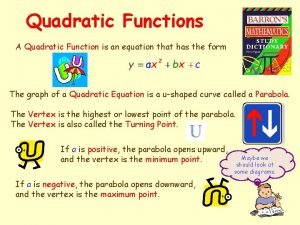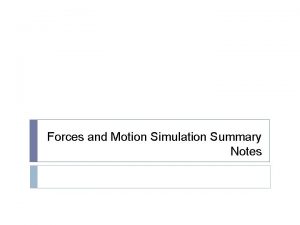Unit 5 Notes F ma Fy Upward Forces















- Slides: 15

Unit 5 Notes

∑F = ma ∑Fy = Upward Forces – Downward Forces = may ∑Fx = Forces to Right – Forces to Left = max (∑ means the summation) ∑F is the net force.

∑F = Fnet ∑F = ma *Keep in mind that a positive net force means acceleration in the positive direction *A negative net force means acceleration in the negative direction

Example: A 50 kg person in an elevator accelerates upward at 2 m/s 2. Solve for the normal force. ∑Fy = FN + Fg =ma FN + (50 kg * -9. 8 N/kg) = 50 kg * 2 m/s 2 FN – 490 N = 100 N FN = 590 N

Example 2 A 70 kg para-sailer gets pulled by a cable that makes a 45 degree angle with horizontal. If the person’s acceleration is 3 m/s/s straight forward, and the tension in the cable is 500 N, solve for the drag force. What is the lift provided by the parachute?

∑Fx = Fx + Fwind/Person = max -500 N * cos(45) + Fwind/Person = 70 kg * -3 m/s/s -353 N + Fwind/Person = -210 N Fwind/Person = 243 N

∑Fy = Fy + Fparachute/Person + Fg = 0 -500 N * sin(45) + Fparachute/Person + 70*9. 8 = 0 -353 N + Fparachute/Person + 686 N = 0 Fparachute/Person = 333 N

Forces and Kinematics •

Example • A 50 kg track star uniformly accelerates as he runs the first 25 m in his race. Calculate the force necessary for him to run this in 4 s. Since we’re calculating force, we should start with kinematics.

a=? x=40 m x 0=0 v 0=0 t=4 s

Two-Body Problems If two objects are connected so that they have the same acceleration, it can be useful to think of them as a system. ∑Fsystem = msys a

Example A 2 kg mass hangs off a table. A 6 kg block is on the table. Assume friction is negligible. 1) Solve for the acceleration of the block and mass. 2) Solve for the tension in the cable.

The force causing the block and mass to accelerate is the force of gravity on the hanging mass, so ∑Fsystem = Fg, mass= msys a (2 kg)(-9. 8 N/kg) = (8 kg)a a=-2. 45 m/s/s

To solve for the tension, look at either the individual mass or the individual block. I chose the block. ∑Fblock = mblock a = FCable/block = (2 kg) (-2. 45 m/s/s) FCable/block = -4. 9 N

Alternatively, using the mass should yield the same result. Be careful of the signs. The mass is accelerating downward, which I have defined to be negative in this case. ∑Fmass = Fg+ FCable/mass =m a (2 kg)(-9. 8 N/kg) + FCable/mass =(2 kg)(-2. 45 m/s/s) -19. 6 N + FCable/mass = -4. 9 N FCable/mass = 24. 5 N
 Example of like parallel forces
Example of like parallel forces The forces shown above are
The forces shown above are Intermolecular forces vs intramolecular forces
Intermolecular forces vs intramolecular forces Difference between intramolecular and intermolecular
Difference between intramolecular and intermolecular Covalent bond intermolecular forces
Covalent bond intermolecular forces What are some contact forces and some noncontact forces?
What are some contact forces and some noncontact forces? Force examples in everyday life
Force examples in everyday life Constructive and destructive forces examples
Constructive and destructive forces examples Unit 6 review questions
Unit 6 review questions Cube wisc
Cube wisc Upward basketball practice plans
Upward basketball practice plans Trickle-down theory fashion examples
Trickle-down theory fashion examples Upward rotation of scapula
Upward rotation of scapula The seven habits paradigm
The seven habits paradigm When does a parabola open upward
When does a parabola open upward Classify emulsifying agents with example
Classify emulsifying agents with example




























